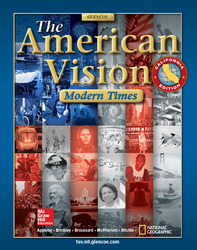

The American Vision: Modern Times, California EditionChapter 17: The Vietnam WarChapter OverviewThis chapter looks at how the United States involvement in the Vietnam War divided the nation and impacted American society. 17.1 The United States Focuses on Vietnam Section 1 explains the origins of the United States' involvement in Vietnam. After the Vietnamese nationalists succeeded in ousting Japanese forces from their land during World War II, their leader, Ho Chi Minh, led a campaign to win Vietnam's independence from French colonial rule. France, unwilling to lose its colonial empire in Southeast Asia, asked the United States for assistance. The Korean War and Ho Chi Minh's Communist ties convinced Truman to begin a massive program of military aid to French forces in Vietnam. However, this support could not keep French forces from crumbling under the Vietminh's guerilla attacks. When the French withdrew from Indochina, the Geneva Accords divided French Indochina and gave Ho Chi Minh temporary control of North Vietnam. The United States stepped in and became protector of the new nationalist government of South Vietnam. The promised national elections never occurred, and tensions between North and South Vietnam intensified. Vietnam was headed for civil war, and the United States was caught in the middle of it. 17.2 Going to War in Vietnam Section 2 describes how American involvement in Vietnam deepened during the 1960s. As Ho Chi Minh's army, the Vietcong, began an armed struggle to reunify Vietnam, the United States increased military aid and sent military advisors to the South Vietnamese. In 1964 North Vietnamese attacks on American destroyers led President Johnson to ask Congress for the authority to use force to defend American troops. A few days later Congress passed the Gulf of Tonkin Resolution, authorizing the president to widen the war. A confident United States began sending combat troops to fight against the Vietcong while flying sustained bombing raids on North Vietnam. The Vietcong's strength and stamina surprised the United States, and their use of surprise tactics and guerilla warfare frustrated American troops. American forces countered with chemical weapons and napalm, but by the mid-1960s American casualties mounted, and the Vietcong and North Vietnamese showed no sign of surrendering. 17.3 Vietnam Divides the Nation Section 3 looks at how the war drew sharp divisions between those who supported the war and those who did not. Many Americans supported the military effort when the first American troops landed in Vietnam in the spring of 1965. As the war dragged on, however, grim television coverage of the war began to conflict with optimistic government reports. Americans grew less confident in President Johnson's administration and less supportive of the war. Young people questioned the draft and refused to serve. Antiwar activists staged teach-ins, protest demonstrations, and marches. As hawks and doves debated the war, troubling events in 1968 sent the nation reeling. A large-scale Communist attack in South Vietnam shook Americans' confidence in the war effort. President Johnson shocked the nation by announcing he would not seek reelection. Then Robert Kennedy, a presidential hopeful, and Martin Luther King, Jr., a beloved civil rights leader, were assassinated. When violence spread to the Democratic convention, voters looked for a leader who would restore unity and order. They chose Republican Richard Nixon in the 1969 presidential election. 17.4 The War Winds Down Section 4 details the events that led to the end of the Vietnam War. Hoping to bring a diplomatic end to the war, President Nixon authorized secret negotiations between the United States and the North Vietnamese. Nixon's strategy for ending the war included cutting back the number of American troops in Vietnam while increasing air strikes to ensure bargaining power. At home, reports of a civilian massacre and an invasion of Cambodia fueled antiwar opposition and sparked violent demonstrations. Support for the war weakened further when a government report known as the Pentagon Papers undermined the government's credibility. Under mounting pressure to end the war, Nixon agreed to drop some of his conditions for peace, and in 1973 leaders signed a peace treaty. The treaty, however, would not prevent South Vietnam from falling under North Vietnamese control, heal veterans' and refugees' suffering, or stop the increasing cynicism Americans felt about their government. |  |















